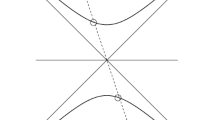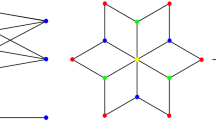Abstract
In this paper, we consider immersed two-sided minimal hypersurfaces in \(\mathbb {R}^n\) with finite total curvature. We prove that the sum of the Morse index and the nullity of the Jacobi operator is bounded from below by a linear function of the number of ends and the first Betti number of the hypersurface. When \(n=4\), we are able to drop the nullity term by a careful study for the rigidity case. Our result is the first effective Morse index bound by purely topological invariants, and is a generalization of Li and Wang (Math Res Lett 9(1):95–104, 2002). Using our index estimates and ideas from the recent work of Chodosh–Ketover–Maximo (Minimal surfaces with bounded index, 2015. arXiv:1509.06724), we prove compactness and finiteness results of minimal hypersurfaces in \(\mathbb {R}^4\) with finite index.
Similar content being viewed by others
References
Anderson, M.T.: The compactification of a minimal submanifold in euclidean space by the gauss map, (Preprint IHES) (1984)
Bernstein, S.: Über ein geometrisches theorem und seine anwendung auf die partiellen differentialgleichungen vom elliptischen typus. Mathematische Zeitschrift 26(1), 551–558 (1927)
Choe, J., Hoppe, J.: Higher dimensional schwarz’s surfaces and scherk’s surfaces, arXiv preprint arXiv:1607.07153 (2016)
Choe, J.: On the existence of higher dimensional ennepers surface. Commentarii Mathematici Helvetici 71, 556–569 (1996)
Choe, J.: Index, vision number and stability of complete minimal surfaces. Arch. Ration. Mech. Anal. 109(3), 195–212 (1990)
Chodosh, O., Ketover, D., Maximo, D.: Minimal surfaces with bounded index, arXiv preprint arXiv:1509.06724 (2015)
Chodosh, O., Maximo, D.: On the topology and index of minimal surfaces, arXiv:1405.7356 (2014)
Costa, C.J.: Example of a complete minimal immersion in \(\mathbb{R}^3\) of genus one and three-embedded ends. Boletim da Sociedade Brasileira de Matemática—Bulletin/Brazilian Mathematical Society 15(1), 47–54 (1982)
Cao, H.-D., Shen, Y., Zhu, S.: The structure of stable minimal hypersurfaces in \(\mathbb{R}^{n+1}\). Math. Res. Lett. 4(5), 637–644 (1997)
do Carmo, M., Dajczer, M.: Rotation hypersurfaces in spaces of constant curvature. Trans. Am. Math. Soc. 277(2), 685–709 (1983)
do Carmo, M., Peng, C.-K.: Stable complete minimal surfaces in \(\mathbb{R}^3\) are planes. Bull. Am. Math. Soc. 1(6), 903–906 (1979)
Fischer-Colbrie, D.: On complete minimal surfaces with finite morse index in three manifolds. Invent. Math. 82(1), 121–132 (1985)
Fischer-Colbrie, D., Schoen, R.: The structure of complete stable minimal surfaces in 3-manifolds of non-negative scalar curvature. Commun. Pure Appl. Math. 33(2), 199–211 (1980)
Hoffman, D.A., Meeks III, W.: A complete embedded minimal surface in \(\mathbb{R}^3\) with genus one and three ends. J. Differ. Geom. 21(1), 109–127 (1985)
Hoffman, D., Meeks, W.H.: Embedded minimal surfaces of finite topology. Ann. Math. 131(1), 1–34 (1990)
Jagy, W.C.: Minimal hypersurfaces foliated by spheres. Mich. Math. J. 38(2), 255–270 (1991)
Jorge, L.P., Meeks, W.H.: The topology of complete minimal surfaces of finite total gaussian curvature. Topology 22(2), 203–221 (1983)
Lopez, F.J., Ros, A.: Complete minimal surfaces with index one and stable constant mean curvature surfaces. Commentarii mathematici Helvetici 64(1), 34–43 (1989)
Li, P., Wang, J.: Minimal hypersurfaces with finite index. Math. Res. Lett. 9(1), 95–104 (2002)
Morabito, F.: Index and nullity of the gauss map of the Costa–Hoffinan–Meeks surfaces. Indiana Univ. Math. J. 58(2), 677–707 (2009)
Montiel, S., Ros, A.: Schrödinger operators associated to a holomorphic map. Global differential geometry and global analysis, pp. 147–174. Springer, Berlin (1991)
Michael, J.H., Simon, L.M.: Sobolev and mean-value inequalities on generalized submanifolds of \(\mathbb{R}^n\). Commun. Pure Appl. Math. 26(3), 361–379 (1973)
Mei, J., Senlin, X.: On minimal hypersurfaces with finite harmonic indices. Duke Math. J. 110(2), 195–215 (2001)
Nayatani, S.: Morse index of complete minimal surfaces. The problem of Plateau, pp. 181–189. World Scientific Publisher, River Edge (1992)
Pogorelov, A.V.: On the stability of minimal surfaces. Sov. Math. Dokl. 24, 274–276 (1981). (English)
Ros, A.: One-sided complete stable minimal surfaces. J. Differ. Geom. 74(1), 69–92 (2006)
Savo, A.: Index bounds for minimal hypersurfaces of the sphere. Indiana Univ. Math. J. 59(3), 823–837 (2010)
Schoen, R.M.: Uniqueness, symmetry, and embeddedness of minimal surfaces. J. Differ. Geom. 18(4), 791–809 (1983)
Sharp, B: Compactness of minimal hypersurfaces with bounded index, arXiv preprint arXiv:1501.02703 (2015)
Schoen, R., Yau, S.T.: Harmonic maps and the topology of stable hypersurfaces and manifolds with non-negative ricci curvature. Commentarii Mathematici Helvetici 51(1), 333–341 (1976)
Shen, Y.-B., Zhu, X.-H.: On stable complete minimal hypersurfaces in \(\mathbb{R}^{n+1}\). Am. J. Math. 120, 103–116 (1998)
Tanno, S.: \(l^2\) harmonic forms and stability of minimal hypersurfaces. J. Math. Soc. Japan 48(4), 761–768 (1996)
Tysk, J.: Finiteness of index and total scalar curvature for minimal hypersurfaces. Proc. Am. Math. Soc. 105(2), 429–435 (1989)
Tam, L.-F., Zhou, D.: Stability properties for the higher dimensional catenoid in \(\mathbb{R}^{n+1}\). Proc. Am. Math. Soc. 137(10), 3451–3461 (2009)
White, B.: Curvature estimates and compactness theorems in 3-manifolds for surfaces that are stationary for parametric elliptic functionals. Invent. Math. 88(2), 243–256 (1987)
Author information
Authors and Affiliations
Corresponding author
Additional information
Communicated by A. Neves.
Appendix A. Minimal hypersurfaces with finite total curvature
Appendix A. Minimal hypersurfaces with finite total curvature
In the appendix we give a brief explanation of proposition 2.4. Namely, we prove that immersed minimal hypersurfaces with finite total curvature in \(\mathbb {R}^n\) is regular at infinity. The proof we include here is a generalization of [33] and [1]. We refer the readers to their original papers for more details.
Proof
Let \(\Sigma ^{n-1}\subset \mathbb {R}^n\) be a minimal hypersurface with finite total curvature, i.e. \(\int |A|^{n-1}< \infty \). We prove that \(\Sigma \) has finitely many embedded ends, each of which is a graph over some affine plane of some function u
The proof can be divided into several steps as follows.
- Step 1:
-
A \(\epsilon \) regularity theorem for |A|.
Consider an annulus \(A(R,2R)=B(0,2R)-B(0,R)\). We have the following:
Proposition A.1
There is an \(\epsilon _0>0\) such that if \(\int _{A(R,2R)\cap \Sigma }|A|^{n-1}<\epsilon _0\) then
Here \(\mu \) is a continuous function satisfying \(\mu (\epsilon )\rightarrow 0\) as \(\epsilon \rightarrow 0\).
This proposition is a direct consequence of the Simons’ equality and the scaling invariance of \(\int |A|^{n-1}\). As a consequence, since the total curvature is finite, we deduce that
- Step 2:
-
Euclidean volume growth.
Recall that by [33] the Morse index of \(\Sigma \) is bounded from above by a constant times the total curvature, and in particular, the index of \(\Sigma \) is finite. We then conclude by [19] that \(\Sigma \) has finitely many ends. We study the asymptotic behavior of each end.
By the Morse-theoretic argument in [35], we see that for \(R>R_0\), the distance function \(r={{\mathrm{dist}}}(\cdot , 0)\) is a Morse function with no critical point. Take R sufficiently large such that \(\Sigma \cap \partial B_R(0)\) transversely, and each connected component of \(\Sigma \cap \partial B_R(0)\) corresponds to an end of \(\Sigma \). We first prove that \(\Sigma -B_{R_0}(0)\) is a collection of finitely many ends, each diffeomorphic to \(S^{n-2}\times [0,\infty )\). In particular, this shows that \(\Sigma \) is properly immersed with finite topology. Let us look at one end V.
Let \(V_{r_0}=\partial B_{r_0}(0)\cap V\) to be level set of r on V. Since
and that \(|A|(r)\le \frac{\mu _1(r)}{r}\), where \(\mu _1\) is the continuous function obtained in step 1, that converges to zero as r tends to infinity, we conclude that
where \(A_{V_r}\) is the second fundamental form of \(V_r\) inside V. By the Gauss equation we conclude that
for every point x on \(V_r\) and every tangential two-plane P in \(T_xV_r\), where \(K_{V_r}\) is the sectional curvature. Since \(\mu _1(r)\rightarrow 0\) as \(r\rightarrow \infty \), \(V_r\) is diffeomorphic to the standard sphere of dimension \(n-2\). Combining this with the Morse-theoretic argument, we conclude that each end of \(\Sigma \) is diffeomorphic to \(S^{n-1}\times [0,1)\). Therefore \(\Sigma \) is properly immersed with finite topology.
Let us prove that \(\Sigma \) has Euclidean volume growth. By the curvature condition A.1 and the standard volume comparision, we see that for each level surface \(V_r\),
Hence by the co-area formula we conclude that V has Euclidean volume growth, i.e.
Since \(\Sigma \) has only finitely many ends at infinity, \(\Sigma \) also has Euclidean volume growth.
- Step 3:
-
Tangent plane at infinity.
Having Euclidean volume growth, consider the varifold limit \(\Sigma _\infty \) of rescaled surfaces \(\frac{1}{r}\Sigma \). By slight abuse of notation we also use \(\Sigma _\infty \) to denote the support of this varifold. For any positive \(\delta >0\), \(\Sigma _\infty -B_\delta (0)\) is the limit of minimal hypersurfaces whose |A| converges to 0 uniformly. Therefore \(\Sigma _\infty \) is totally geodesic outside of 0, i.e. \(\Sigma _\infty \) is a union of hyperplanes through 0.
Choose a radius \(r_0\) sufficiently large such that for any \(r>r_0\) the curvature condition A.1 holds. Consider an end \(V\setminus B_{r_0}(0)\) and its rescalings \(\{\frac{1}{R}(V\setminus B_{r_0}(0))\}\). Previously we know that as \(R\rightarrow \infty \) these rescaled ends converge subsequentially to \(P\setminus \{0\}\) for some hyperplane P. By the curvature condition A.1 we know that
Since the varifold convergence does not increase the density at infinity, the convergence
is in multiplicity one.
Next we point out that the plane P does not depend on the choice of the subsequence in the convergence, that is, each end has a unique tangent plane at infinity. To see this, first note that since \(\Sigma \) has finite index, the end \(V\setminus B_{r_0}(0)\) is stable for sufficiently large radius \(r_0\). Also since for each sequence of \(R_i\rightarrow \infty \) there is a subsequence of \(\{\frac{1}{R_i}(V\setminus B_{r_0}(0))\}\) converging to some hyperplane of multiplicity one, by Lemma 3 of [33] we conclude that this limiting hyperplane is unique.
This means that the each end of the original surface \(\Sigma \) has a unique tangent plane at infinity.
- Step 4:
-
Regular at infinity.
Since each end of \(\Sigma \) converges to a hyperplane of multiplicity one, we deduce that outside some compact set, each end is a graph of bounded slope over the tangent plane at infinity. According to proposition 3 of [28], this end is regular at infinity. \(\square \)




